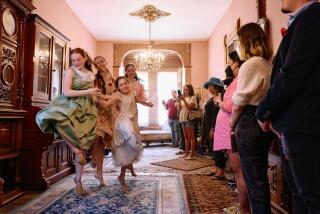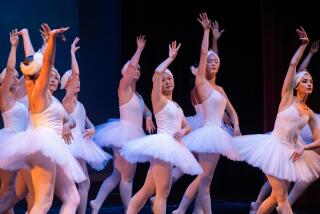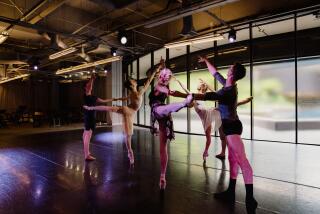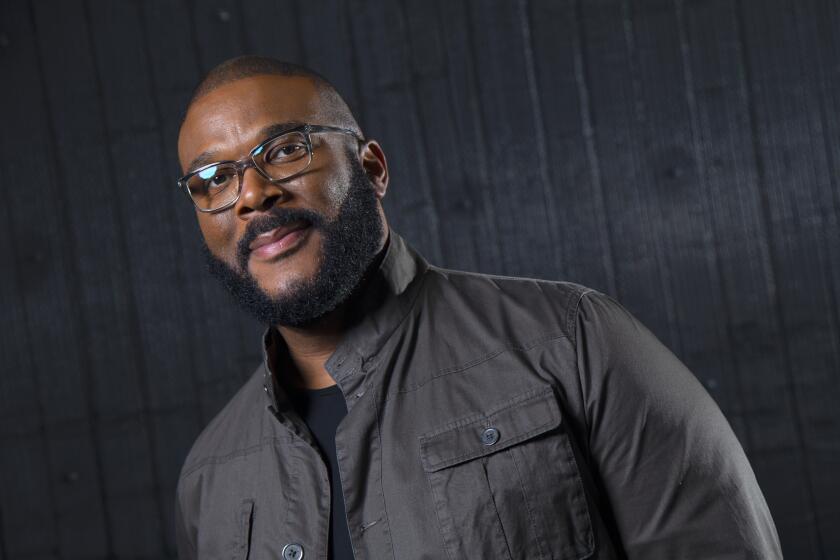Few in ‘Billy the Kid’ Audience Knew of Dancer’s Pain
- Share via
Few in the audience who saw Alexander Kolpin dance the title role of Eugene Loring’s “Billy the Kid” for the first time last week at UC Irvine knew the physical pain he was in.
A muscle tear and stress fracture in the shin that he endured for almost a year and a half finally sent the principal dancer and rising star with the Royal Danish Ballet to the operating room in May.
It also knocked him out of a tour with some of his Danish colleagues who will appear Sunday at the Universal Amphitheatre in Los Angeles.
Kolpin’s doctor had allowed him to dance Billy because the role does not require the airy jumps and intricate foot-beats characteristic of the Danes’ Bournonville style.
“It’s been quite painful and still is and it swells a lot,” Kolpin said in a recent interview. He said he was “on a lot of (pain) pills” while dancing at UCI, but otherwise was all right.
He said he needed to dance to find out if the corrective surgery would “hold or not hold.”
“Also, it’s very mental. You get scared, so you block. What happens after having an injury for so many months, you just start living with the pain and the fear. So you really cannot judge when it hurts and when it’s sore. It’s really scary.
“At some point, you have to get beyond being frightened of doing anything. Yeah, I’m frightened. Whenever I feel just a little thing, (I think), OK, now the whole thing is going to break again.”
Although the surgery is now behind him, Kolpin anticipates “a lot of pain for the next year and swelling of the bone and all that.”
Kolpin, who turned 24 on Thursday, paused long and thoughtfully before answering what it was like to work with the UCI students.
“It’s difficult,” he said. “They have been so nice, really very, very nice. It’s always hard, because you see, if I go and dance with the Boston Ballet, a professional company, you pull each other up. But for me, I don’t really have so much support in the other dancers. . . .
“I’m not talking about (their) not being engaged in it. But they’re not at a very high technical level.”
Kolpin, however, thought it was his duty to interact strongly with them.
“If you come and do a pas de deux, it’s no problem,” he said. “But if you come and do a ballet like this, you have to relate to the persons who are there on stage or else it’s not going to work. I’m just going to seem out of place.
“That’s the most important thing--to relate to the people that you dance with on stage. . . . Art is not personal exposure and showoff of yourself.”
That was a lesson he tried to convey to the students who danced the pas de deux from Bournonville’s “Flower Festival in Genzano” on the program.
“Those dancers very much danced to the audience, and I said, forget that. This is not a Russian pas de deux, (in which) one comes in and dances and runs out. . . . This is a pas de deux, which means step for two. So you’re dancing for each other.
“You’re just lovers taking a walk in the woods. You dance for your lover. . . . ‘Oh, you look so gorgeous, now I want to dance for you. You look beautiful. We cannot stop it.’ That’s what I tried to get the idea for them. . . . The audience just happens to be there that night.”
Such an attitude does not rule out the unexpected, however.
“I believe it’s very exciting when you go on stage and unpredictable things happen,” he said. “I really get excited by chance.”
Several such “chances” happened on opening night.
A left-hander, he made the mistake of stealing the jailer’s gun with his right hand, then shooting him with his left. So he had to improvise a quick change to account for the difference. Few people noticed.
He also got ahead of the music in his first solo, he said, and simply doubled Billy’s quick back-and-forth paranoid turns.
When one of the other characters couldn’t make his entrance on time because he was still adjusting his costume, Kolpin had to improvise by riding around the stage a few extra times, he said.
Another improvisation included kissing one of the Mexican Girls after they shielded him from a posse.
“All that (improvisatory) stuff-- that makes the ballet move, that makes it live, that makes it exciting,” he said.
Kolpin was 11 when he decided to follow his sister to a dance class. “I just went to watch one day, and I thought it was strange there were no boys,” he said. “So I said to my mother that I wanted to attend the classes.”
A year later, his teacher recommended that he audition for the Royal Danish Ballet. But his parents weren’t sure that he was serious enough and recommended another year of study. By then, although he had passed the company’s age limit of 11 for its school, his teacher, once a principal with the Danes, worked out an arrangement, and after a while he was accepted into the school.
“What was so nice for me was I had no ambitions when I started,” Kolpin said. “I just thought it was nice to move. I was crazy about moving and using my body, whatever it was--soccer, running. I’ve always been very energetic. And very hyper. I am very hyper.”
He became a principal dancer 18 months ago and was injured shortly afterward. Being a member of the Danish Ballet gives him job security, however.
“In New York, if somebody gets an injury, well, you’re just history, you’re out,” he said. But his status with the Danes would allow him a retirement pension if his injury would sideline him permanently, he said.
Fortunately, that does not appear to be the case, and he has begun discussing a possible return to UCI next summer to stage and dance in the third act of Bournonville’s “Napoli,” he said.
But Kolpin said he does not eat, sleep and breathe ballet.
“When I’m not at the company, I do so many other things. I read and I surf and I like to listen to music. And I like to build things.
“It’s very important when you’re a dancer, you shouldn’t go home and sit and read your Dance Magazine and do your slippers and talk with your ballet friends and watch the ballet video because you’re just going to die. Your art is going to dry up very slowly.”
More to Read
The biggest entertainment stories
Get our big stories about Hollywood, film, television, music, arts, culture and more right in your inbox as soon as they publish.
You may occasionally receive promotional content from the Los Angeles Times.










